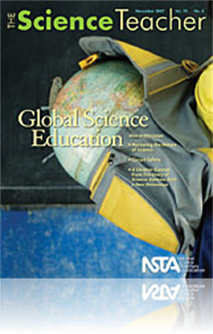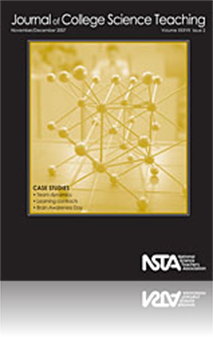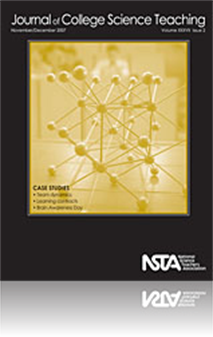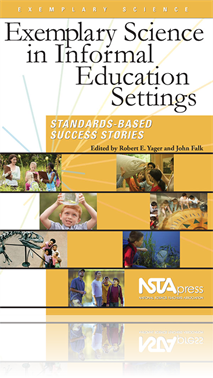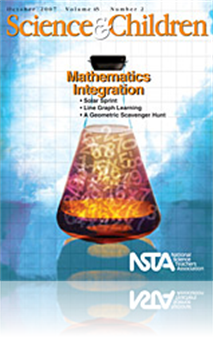All Resources
Journal Article
Editor’s Corner: A Flat World?
Beyond preparing our students for imminent economic realities, we should prepare them to think globally. American economic competitiveness in a global economy is a significant challenge that will be addressed at least in our schools. But the greatest...
Journal Article
Science Sampler: Modeling the effects of drugs on the brain
The following activity teaches students about the neurobiological consequences of drug use on their brains and behavior. Students make clay models that allow them to visualize how drugs affect neural communication. If you’re concerned that this act...
Journal Article
Editor’s Roundtable: Health Literacy
In his 2003 testimony, the Surgeon General called for combating the obesity epidemic in America by increasing health literacy among our citizens, and especially among the nation’s children. Schools must teach students to lead healthy lifestyles and...
Journal Article
The Building Migratory Bridges (BMB) program—a collaboration between the Marvelwood School and Audubon Sharon in Connecticut and Conservation Research Education Action (CREA), a U.S. not-for-profit in Panama—uses neotropical migratory bird resear...
Journal Article
This article describes an approach to minimizing the “fear factor” in a chemistry course for the nonscience major, and also addresses relevant applications to other science courses, including biology, geology, and physics. The approach emphasizes...
Journal Article
Every Day Science Calendar—November 2007
This monthly feature contains facts and challenges for the science explorer. ...
Journal Article
Teaching Through Trade Books: Words to the Wild
A notebook is perhaps the single most important piece of equipment a naturalist takes into the field. But notebooks are not only for use by field scientists: They are also excellent tools for helping students record observations outdoors, develop com...
Journal Article
Thomas Locker’s book about nature entitled Water Dance (1997) provides the basis for this interdisciplinary project on Earth’s water cycles. Through thoughtful consideration of the text and art in Water Dance, students build and express deep...
Journal Article
Case Study: Why I Like Clicker Personal Response Systems
For those of you unfamiliar with clicker personal response systems, a clicker is a handheld remote that students use to enter their responses to multiple choice questions. The question is displayed on the classroom overhead screen, usually within a P...
Journal Article
Idea Bank: Clay Pot Refrigerators
Access to refrigeration is something we take for granted in the United States. However, for many countries refrigeration is not an option for keeping food fresh. In 1995, a teacher in Nigeria named Mohammend Bah Abba developed and began to popularize...
Journal Article
Tried and True: Making the connection—Addressing students’ misconceptions of circuits
Electricity is an abstract phenomenon that students interact with every day. Interestingly enough, many eighth-grade students do not fully understand the requirements for a complete circuit. In an effort to "short-circuit" misunderstandings, the circ...
Journal Article
Science Sampler: You can learn a lot from your dog
Recently, dogs have been the focus of a great deal of scientific research. In fact, dogs were the inspiration for Professor Bruce Blumberg’s class, The Cognitive Dog: Savant or Slacker, at Harvard University. This course serves as the impetus for...
Journal Article
Scope on the Skies: Neptune—The planet exterior to Uranus
This month, the three most outer planets—Jupiter, Uranus, and Neptune—and one of the larger dwarf planets, Pluto, will be in the evening skies after sunset. While only Jupiter and Uranus will be visible through small telescopes or binoculars, thi...
Journal Article
Peering through a thematic science lens—elementary students embarked on a one-week study of ants during a month-long summer school program. This integrated unit addressed reading and writing skills while developing the science-process skills of obs...
Journal Article
Investigative Labs in Biology: The Importance of Attending to Team Dynamics
This article provides some tips for success in facilitating teamwork. Working collaboratively is common in science and the functioning of teams has a large impact on both the implementation of a research project and student satisfaction with the expe...
Journal Article
Science 101: How is reading science books different from reading other kinds of books?
A good history book tells a story, much like a good novel. In reading those stories, one is able to read through the text relatively quickly and still get the main points. Science reading is a much slower process. You read science texts to understand...
Journal Article
Nurturing the Nature of Science
Historical stories of scientists provide an excellent opportunity to help students see that science is indeed a human endeavor and demonstrate the interrelationships among science, technology, and society. A number of engaging historical accounts ill...
Journal Article
Extra! Extra! Learn All about It
Communication and reporting of findings to peers are important to middle school students. One way to capitalize on students’ interests and incorporate the nature of science into the science curriculum is to have students create a science-based news...
Journal Article
Reinvigorating Science Journals
Science-themed books are wonderful tools for emphasizing the importance of observation and journaling. They can also be used to effectively promote literacy skills in science. This article shares a selection of nature books and the ways teachers and ...
Journal Article
For many years, the remarkable artists and graphic designers at NSTA have given JCST intriguing and delightful covers. However, focus groups and conversations revealed that our attractive covers were triggering, for some people, an image that wasn...
Journal Article
Brain Awareness Day: A Service-Learning Experience in Neuroscience
Three local colleges in the Lehigh Valley collaborate on a service-learning project called Brain Awareness Day to enhance neuroscience literacy among the public regarding the functions of the brain and benefits of brain research. ...
eBook
Using Forensics: Wildlife Crime Scene! (e-book)
With Forensics: Wildlife Crime Scene!, your students investigate an actual crime, learn the science behind animal-species identification, and find out about efforts to fight real-world threats against wild animals. The book is designed to be e...
eBook
Exemplary Science in Informal Education Settings: Standards-Based Success Stories (e-book)
Just as science education doesn’t stop at the schoolhouse door, neither should effective application of the National Science Education Standards. Exemplary Science in Informal Education Settings shows real-world examples of how science education re...
NSTA Press Book
Exemplary Science in Informal Education Settings: Standards-Based Success Stories
Just as science education doesn’t stop at the schoolhouse door, neither should effective application of the National Science Education Standards. Exemplary Science in Informal Education Settings shows real-world examples of how science education re...
Journal Article
Children possess a genuine curiosity for exploring the natural world around them. One third grade teacher capitalized on this inherent trait by leading her students on “A Geometric Scavenger Hunt.” The four-lesson inquiry investigation described ...
Journal Article
Issues In-Depth: The pet food recall puzzle—Who, what, why, and how much?
Last spring, North America was gripped in the largest pet food recall in history. News outlets reported tens of thousands of dogs and cats becoming ill, and many dying, as a result of ingesting contaminated pet food. Several pet owners have filed law...
Journal Article
Biology Education Under the Microscope
For many students, high school science is biology and our best—and sometimes only—opportunity to impact students’ knowledge of and interest in science generally will remain linked to the quality and nature of biology instruction in U.S. high ...
Journal Article
Collecting data and analyzing the results of experiments is difficult for children. The authors found a surprising way to help their third graders make graphs and draw conclusions from their data: digital photographs. The pictures bridged the gap bet...
Journal Article
The Life and Work of John Snow
Due to his work to determine how cholera was spread in the 18th century, John Snow (1813-1858) has been hailed as the father of modern epidemiology. This article presents an inquiry model based on his life and work, which teachers can use to develop ...
Journal Article
In the “Solar Sprint” activity, students design, test, and race a solar-powered car built with Legos. The use of ratios is incorporated to simulate the actual work of scientists and engineers. This method encourages fourth-grade students to think...
Journal Article
Every Day Science Calendar—October 2007
This monthly feature contains facts and challenges for the science explorer. ...
Journal Article
Many students view biology and chemistry as two unrelated, separate sciences; how these courses are generally taught in high schools may do little to change that impression. The study of enzymes provide a great opportunity for both biology and chemis...
Journal Article
Editor’s Note: Science and Math Go Together Like…
The connections of mathematics and science are both basic and complex. As the articles in this month’s issue attest, we can deepen student understanding of science and math through an explicit and thoughtful connection in our lessons. ...



